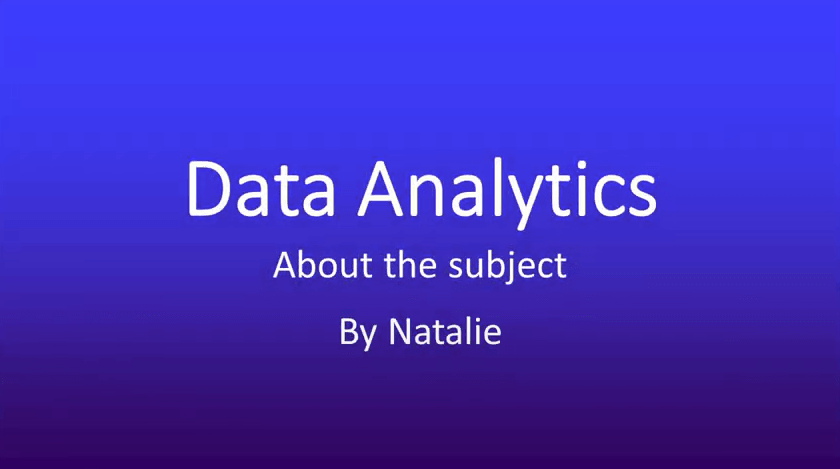VCE Applied Computing focuses on the strategies and techniques for creating digital solutions to meet specific needs and to manage the threats to data, information and software security. Students will develop an understanding of the roles and applications of cybersecurity, data analytics and programming and examine the attributes of an information system, and how their interrelationships affect the types and quality of digital solutions.
Students focus on how data can be used within software tools such as databases and spreadsheets to create data visualisations, and the use of programming languages to develop working software solutions. For more information visit – here.
Area of Study 1 – Data analysis
In this area of study students use software tools to create data visualisations in response to solution needs. Software tools are used for the collection, interpretation and manipulation of data to draw conclusions and create data visualisations that represent their findings. Students will interpret given designs and create database, spreadsheet and data visualisations solutions using the data collected. Students focus on the appropriate functions and techniques to manipulate and validate data and to make use of suitable formats and conventions.
Area of Study 2 – Programming
In this area of study students use a programming language to create a working software solution in response to provided solution requirements. Students apply methods and techniques for creating a working software solution using a range of processing features and data structures. They apply testing and debugging techniques to ensure the software solution works as intended. Students will project manage the development of the solution to support an organised approach to problem solving.
In this unit students focus on developing innovative solutions to needs or opportunities that they have identified and propose strategies for reducing security risks to data and information in a networked environment.
Area of Study 1 – Innovative solutions
In this area of study students work collaboratively to develop an innovative solution to an identified need or opportunity.
They apply all stages of the problem-solving methodology to investigate the use of digital devices and emerging technologies and their applications.
The innovative solution may take the form of a proof of concept, prototype or product. Students choose one of the following topics to explore in greater detail:
- artificial intelligence, machine learning or neural networks
- assistive and wearable technologies or Internet of Things (IoT)
- games development, multimedia programming or web authoring
- mixed realities such as augmented and virtual reality
- research project on innovative uses for emerging technologies such as blockchain
- any other innovative digital solution.
Students will collaboratively project manage the development of the solution to support an organised approach to problem solving.
Area of Study 2 – Network security
In this area of study students investigate how networks enable data and information to be exchanged. Students examine the hardware and software components and procedures required to connect and maintain wired, wireless and mobile communications technology. They apply this knowledge to design a Local Area Network, describe its components and explain the transmission of data and information in this network. Students develop an understanding of cybersecurity issues when they investigate the threats, vulnerabilities and risks to data and information stored within and transmitted across networks and propose strategies for reducing security risks.
Area of Study 1 – Data analytics
In this area of study students’ access, select and extract authentic data from large repositories. They manipulate the data to present findings as data visualisations in response to solution requirements and designs. Students develop software solutions using database, spreadsheet and data visualisation software tools. The software solutions involve importing data from files to a database to identify patterns and relationships. Data is then imported into a spreadsheet for further refinement before presenting findings as data visualisations. Validation and testing techniques are applied to ensure the reasonableness and completeness of the data.
Area of Study 2 – Data analytics: analysis and design
In this area of study students, determine and propose a research question and collect and analyse data. This is the first part of the School-assessed Task (SAT), involving analysis and design, with the second part undertaken in Unit 4, Area of Study 1. A range of methods is used to collect data for analysis. Students generate design ideas for creating their database and/or spreadsheet solutions and infographics or dynamic data visualisations to present findings of their research question investigation.
Area of Study 1 – Data analytics: development and evaluation
In this area of study students develop the design they prepared in Unit 3, Area of Study 2, into infographics or dynamic data visualisations that address the student’s
research question. Effective designs and clarity of messages are key features of infographics and dynamic data visualisations, which are designed to communicate findings intended for a target audience. Students evaluate the quality of their solution and assess the effectiveness of their project management in the development of their project.
Area of Study 2 – Cybersecurity: data and information security
In this area of study students focus on data and information security and its importance to an organisation. Students investigate security strategies used by an organisation to manage the storage, communication and disposal of data and information in their networked environment. They examine the threats to this data and information and evaluate the methods an organisation uses to protect their data and information. Students consider the consequences for an organisation that fails to protect their data and information. They recommend strategies to reduce the threats to data and information, considering the key legal requirements and any ethical issues faced by the organisation.
For further information visit here.
Units 3 and 4 Assessment
School-assessed coursework – 50 percent
and VCAA Written examination – 50 percent

Selection advice
What kind of learner is best suited to study this subject?
Organised, persistent, read criteria carefully
What key skills are required for success?
Attention to detail, consistent work
What are three most engaging topics studied?
Data visualisation, data security, student choice of research topic
What are the learning activities in this subject like?
Data bases. networks, spreadsheets, data visualisations
What advice would you give to a student about to embark on this subject?
It is important to be organised and to understand and be able to apply the assessment criteria






